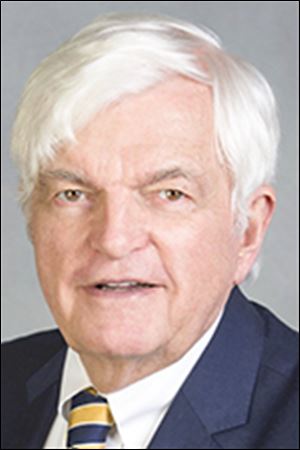
COMMENTARY
Ohio’s young people need options other than college
3/15/2016
Neckers
A recent report rates American colleges and universities according to the starting salaries their graduates earn; the University of Toledo ranks No. 472, and Bowling Green State University No. 512. The typical UT graduate who leaves school with nearly $30,000 in student loan debt may question the value of that investment, even if he or she finds a job.
Sen. Marco Rubio (R., Fla.), who is running for president, has said that young people don’t need to attend college to gain essential job skills. But until high-quality alternatives to higher education become available, colleges will continue to fill their classrooms with people who shouldn’t be there.
Some spectacularly successful people never earned an undergraduate degree; Bill Gates of Microsoft and the late Steve Jobs of Apple come immediately to mind. Both proved themselves to be problem solvers who invented technological paradigms.
But being too creative for the constraints of the college classroom isn’t the problem of most current students. And graduates who are properly prepared remain likely to get jobs. Still, students who attend college with the expectation that they will get a degree, and then inevitably a job, have been sold a bill of goods by the academic establishment, especially public higher education.
For years, students have been told that they are consumers to be retained. Student retention is good business for a state university, but may not always be good for students. Flunking out has taught many more persons the lessons of life than has retention for the wrong reasons.
Some suggestions for higher education in Ohio:
● State universities need better lay leadership. Members of the boards of trustees of public universities need to be community leaders, not political operatives.
● The effort by then-Gov. Ted Strickland to give budget control of all state universities to the Ohio Board of Regents was a political grab that has failed miserably. Such control should return to the trustees of each institution.
● Not every 18-year-old is college material. State universities’ admissions standards must ensure that students are both smart enough and motivated enough to be there.
● Graduate programs must educate students, not enable faculty careers. The state should vigorously promote focused programs that prepare graduate students for the market. Because research productivity leads to new businesses, graduate degree programs should require research.
● We need to take better care of young people who are not ready for college by initiating a public-service program for which every 18-year-old in Ohio is eligible. Public money would pay young people in this job corps, for example, to fill potholes, fix water lines, and find ways to keep Lake Erie clean.
The program should provide remediation. If participants don’t know how to read, teach them. If they can’t add and subtract, teach them to do that too. After two years of hard work, students who are ready to go to college should get help to do so.
If this model sounds old-fashioned, it is. The American military did a pretty good job with it during World War II.
Douglas C. Neckers, of Perrysburg, is a former chairman of the chemistry department and director of the Center for Photochemical Sciences at Bowling Green State University.